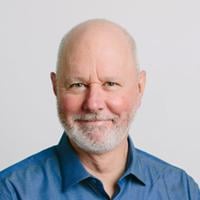Imagine if right now you could sit down and talk to a physician who is deeply versed in pandemics and a brilliant writer to boot. That would be Dr. Kevin Patterson. Except, wait, you might not want to sit down with Patterson. Because, you know, social distancing.
The next best thing is to spend a calmly informing hour watching the video above.
It was recorded Friday evening on Salt Spring Island where Patterson lives. Hosted by UBC professor Michael Byers for the Salt Spring Forum, Patterson converses with Aletha Humphreys, the executive director of Greenwoods Eldercare Society on Salt Spring.
Patterson practices medicine in Nanaimo, on the west coast of Hudson Bay, and on Salt Spring. He specializes in general internal and critical care medicine, and his field includes the promotion of health and prevention of disease. Among the acclaimed books he’s authored is the novel Consumption, which focuses on diseases amongst the Inuit.
Last week Patterson published in the Walrus magazine “Anatomy of a Pandemic” about COVID-19, a piece the Tyee highly recommends.
In a wide ranging conversation with Humphreys and then answering questions submitted remotely by Salt Spring residents, Patterson addresses many aspects of COVID-19 and its health and social impacts.
He notes this coronavirus appears to match the mortality rate of the Spanish flu, and “the speed in which it’s come on is unprecedented in our time.”
He explains why measures that worked to suppress the most recent SARS and H1N1 viral epidemics haven’t worked this time, noting that China’s radical lock-down response to COVID-19 (despite an initial lack of transparency) deserves respect and emulation.
“It’s hard not to be concerned that we are not acting more quickly,” says Patterson, pointing to efforts in Taiwan, Singapore, Hong Kong that have best managed the outbreak through “massive testing, and testing of known contacts for those who test positive, and keeping those infected at home and out of the community.”
The “astonishing” success of the Taiwan experience, he says, “has to be understood within the context of high travel between Taiwan and China.”
Shifting to virus-slammed Korea, Patterson finds good lessons there as well. “It looked like they were teetering on a Wuhan-like calamity,” but the “success of its public health effort is borne out by fact their new cases are dropping. They’ve wrestled it, they’ve gotten control of it, and there are a lot of reasons to be optimistic.”
The big takeaway from these examples, says Patterson, is it’s very important for governments to make testing easy and widely available, and to decree as early as possible social distancing on a personal level, and on a larger scale such as closing schools and cancelling events.
“We’re going to do it sooner or later” in Canada, he says. “Better to do it too soon rather than too late.”
Too late leads to an “Italy type situation,” and at this point, “only the most determined optimist would say that’s impossible” in Canada.
The death rate for COVID-19 patients in Italy now rests above eight per cent, a grim statistic that Patterson says is significantly tied to the fact Italy’s population trends older and intensive care units have been overwhelmed by the surge of desperately ill patients, meaning some can’t be properly cared for and saved.
The benefit of early testing, social distancing and self-isolation on a widespread scale, he says, is that the surge is flattened, extending a similar number of cases over a longer period of time.
Patterson notes that the mean age for Salt Spring Island is 55, nine years higher than in Italy. “I would characterize our vulnerability as high.” He adds, “All of southern Vancouver Island is a relatively old population.”
One person asked Patterson to list the underlying medical conditions that put a person particularly at risk for succumbing to COVID-19. He cited chronic obstructive pulmonary disease (COPD), emphysema, asthma, and, based on results in China, hypertension. He added that people were much more at risk if for any reason their immune system was suppressed, noting that is the case for people on steroids for conditions such as rheumatoid arthritis or lupus.
Another person asked whether child educators were at particular risk, since children may carry the virus and show little or no effects.
Patterson noted that in Japan when flu vaccines for children were made mandatory, the death rate for the elderly dropped, indicating that many were contracting the virus from youngsters. But right now COVID-19 testing is not allowed for asymptomatic people, including children.
Patterson refused to predict how dire the effects of COVID-19 would become in Canada, flatly declaring, “Nobody knows.”
But he reminded that pandemics are a “shock to the system” that “breaks things.”
He warned against the “othering” that happens when “people in fear act badly.”
“What will be the behaviour of people when they are vastly more anxious than now? That’s pretty concerning to me.”
He thinks it strange that our governments spend millions on earthquake reinforcement but haven’t shown the same foresight for preparing for viral pandemics. While COVID-19 is proving more dangerous than the SARS and H1N1 epidemics, “it’s the third such event we’ve had in 20 years. Where are the warehouses full of ventilators and protective gear for health workers?”
Humphreys, a probing interviewer matching Patterson’s cool and collected demeanor, compares responses to COVID-19 and the far more slowly unfolding climate crisis.
“With this crisis it’s become very personal in a very fast manner,” she says. “When we talk about the impact of the virus it’s immediate with us and with the people we identify. With climate change it still feels very arms’ length.”
Perhaps COVID-19 is a wake-up call that will allow us “to draw parallels and use that to say they are very similar,” she said.
“Epidemics can transform thought,” agrees Patterson. “It can tear down old dogmas and open people’s eyes to new ways of doing things.”
The video conversation yields many more insights beyond those pulled out here. Watching it is not a bad use of an hour in these self-isolating times. As Patterson says, “We could all be sitting at home playing a lot of Scrabble for a while.” ![]()
Read more: Health, Coronavirus















Tyee Commenting Guidelines
Comments that violate guidelines risk being deleted, and violations may result in a temporary or permanent user ban. Maintain the spirit of good conversation to stay in the discussion.
*Please note The Tyee is not a forum for spreading misinformation about COVID-19, denying its existence or minimizing its risk to public health.
Do:
Do not: